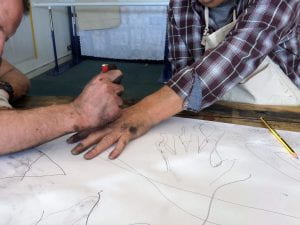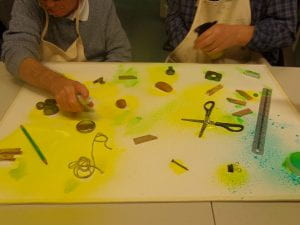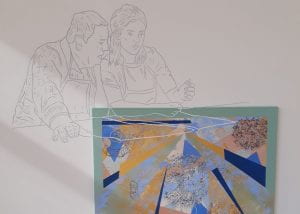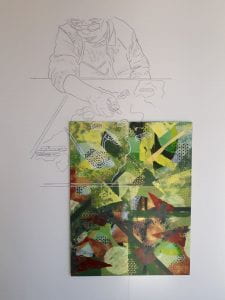Research Question:
“How can the creation of a collaborative studio environment enable adults with acquired brain injuries to overcome personal barriers and begin to create an artistic identity?”
Headway Milton Keynes
This research project took place at Headway Milton Keynes. Headway is a national charity for people who have experienced traumatic and acquired brain injuries. Brain injuries can affect people in many different ways, with common difficulties including limited mobility, weakness or paralysis of limbs, ataxia (uncontrolled movement), difficulties with speech, aphasia (language loss), memory problems and personality changes. For more information please visit the Headway UK website: https://www.headway.org.uk/
Research Process
The Research took place over ten weeks in a space which we collectively transformed into a temporary studio. Together we discussed what it meant to collaborate and what was needed to create a studio. It was crucial that the participants set this framework, not only from an inclusion perspective, but also so we had something tangible to regularly revisit and measure our journey against.
I primarily used drawing and painting materials in the research sessions as they are the basis of my own art practice. I have found in the past that they can be difficult mediums for some people to feel confident using, so I was keen to explore some new techniques. In the first weeks we used simple mark-making to get used to the materials. I then introduced objects and artist images for inspiration and as starting points for further explorations.
Whilst the research initially had a focus on collaborative art-making, the sessions revealed that what people most needed and wanted was the space to embark upon their own creative journeys.
Key Research Findings
- Recognise that every person with an Acquired Brain Injury is different and will need an personalised approach to art-making
- Create a space that promotes memory; art displays, sketchbooks and music chosen by participants
- Volunteers are an invaluable resource, helping to ensure people get the most from their studio time
- Colour charts, an image bank and interesting objects support creativity and independence
- Artist discussions provide insight into people’s interests and spark intelligent discussions
- Build time for 1 to 1 discussions e.g. tutorials to give those with communication challenges time to share
Exhibition
The research culminated in an exhibition of a personal creative response at the end of year Brighton University MA show in July 2019. My creative response was an installation piece, designed to emulate key aspects of an inclusive studio environment for adult with acquired brain injuries, including; different working relationships, accessible and memory-provoking painting methods, and non-tie aprons which facilitated independence. A desk and chair provided a space for personal reflection and a question posed for viewers to contemplate; ‘When or where do you feel most like yourself?’
Email: sophierobyn17@gmail.com
Instagram: @sophierobynbennett










